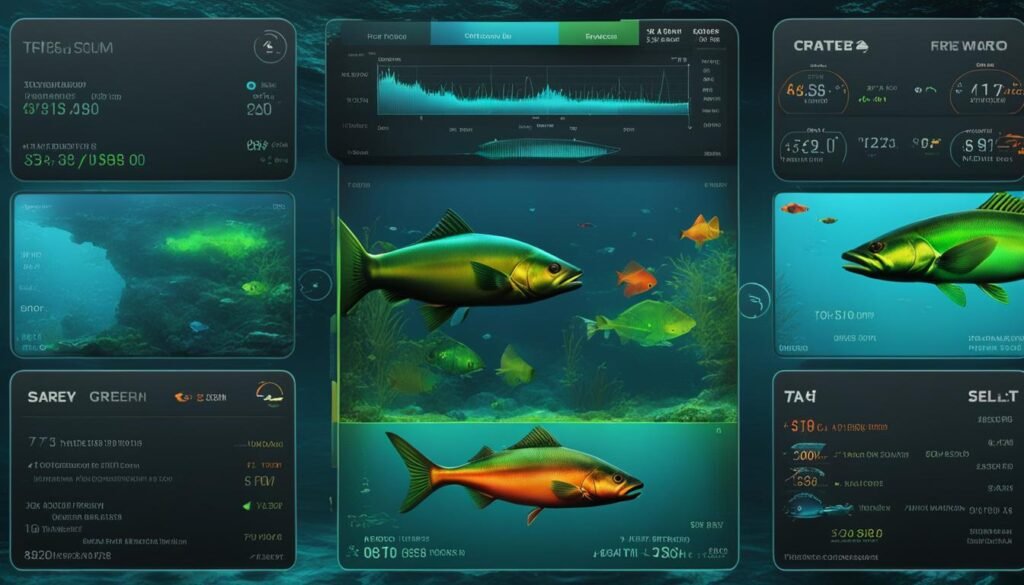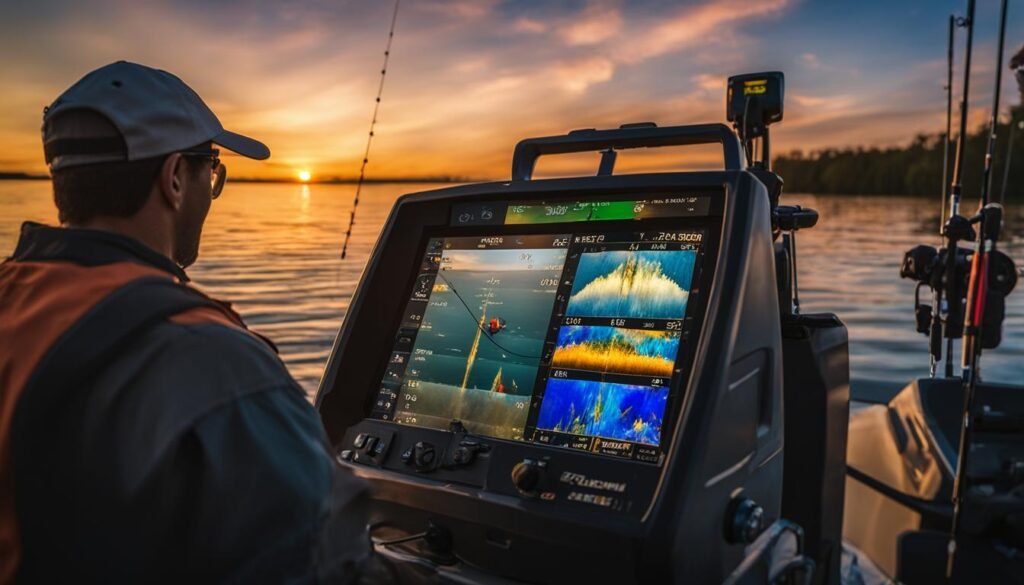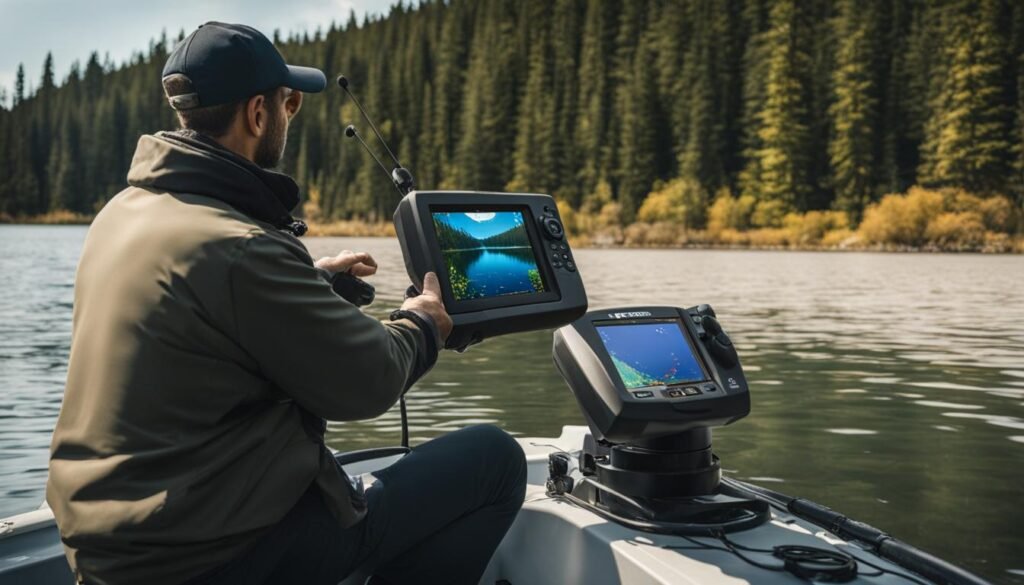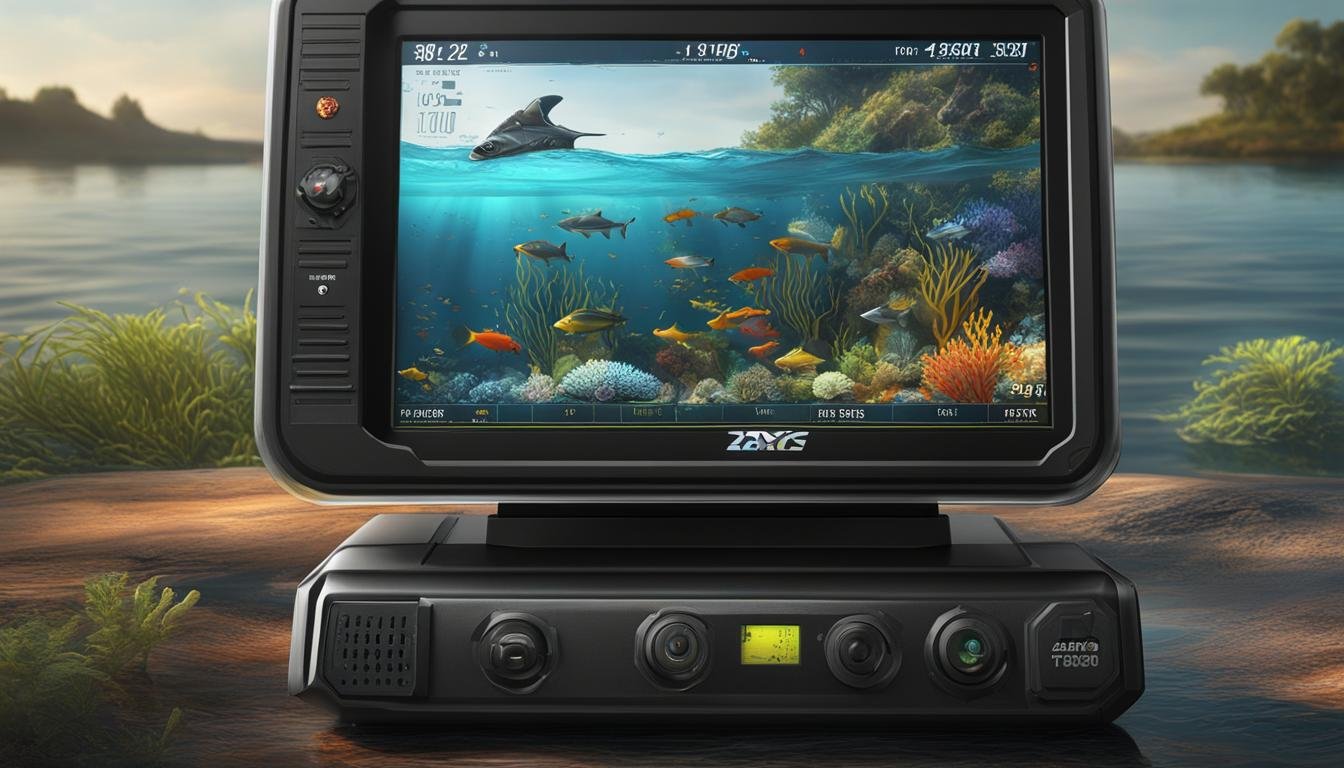Table of Contents
Welcome to our comprehensive guide on using a fish finder to enhance your fishing success. Whether you’re an experienced angler or just starting out, understanding how to effectively use a fish finder can greatly improve your chances of catching more fish.
In this article, we’ll provide you with all the information you need to unlock the full potential of your fish finder.
A fish finder is a valuable tool that uses sonar technology to detect and locate fish underwater. By understanding how it works and knowing how to interpret the readings on the display screen, you can gain valuable insights into fish behavior, identify optimal fishing spots, and increase your chances of success on the water.
Throughout this article, we’ll cover everything from the basics of fish finders to advanced tips and techniques. We’ll guide you through selecting the right fish finder for your needs, setting it up for optimal performance, and reading the screen to identify fish signatures and underwater structures.
We’ll also provide practical applications for using your fish finder on the water and troubleshoot common issues that you may encounter.
Key Takeaways:
- Understanding how to use a fish finder can greatly enhance your fishing success.
- A fish finder uses sonar technology to detect and locate fish underwater.
- By selecting the right fish finder and setting it up correctly, you can maximize its potential.
- Reading the fish finder screen and interpreting the sonar readings is essential for identifying fish signatures and underwater structures.
- Using a fish finder in different fishing scenarios, such as shallow water or deep water, requires specific techniques and strategies.
Understanding the Basics of Fish Finders
In order to make the most of your fishing trips, it’s important to have the right tools at your disposal. One tool that has revolutionized the way anglers locate fish is the fish finder. In this section, we will dive into the basics of fish finders, including what they are, how they work, the different types available, and the key features to look for when selecting one.
What is a Fish Finder and How Does it Work?
A fish finder is a device that utilizes sonar technology to detect and locate fish underwater. Sonar, short for Sound Navigation and Ranging, works by emitting sound waves into the water. These sound waves travel through the water and bounce off objects, including fish.
The fish finder then interprets the returning sound wave patterns to display a visual representation of the underwater environment on its display screen.
The Different Types of Fish Finders
There are various types of fish finders available in the market, each catering to different fishing needs and preferences. The most common types include:
- Fixed-mount fish finders: These fish finders are permanently installed on boats and provide a comprehensive view of the underwater environment.
- Portable fish finders: Portable fish finders are compact and easy to transport. They often come with a transducer that can be attached to the hull of a boat or cast into the water.
- Castable fish finders: Castable fish finders are designed to be cast into the water using a fishing rod. They are ideal for bank fishing, kayak fishing, or ice fishing.
Key Features to Look for in a Fish Finder
When selecting a fish finder, it’s important to consider the following key features:
- Display screen: Look for a fish finder with a high-resolution display screen that provides clear and detailed underwater images.
- Transducer: The transducer is the component that emits and receives sonar signals. Ensure that the fish finder comes with a quality transducer for accurate readings.
- Scanning capabilities: Fish finders can have different scanning capabilities, such as down imaging, side imaging, and traditional sonar. Choose the scanning technology that suits your fishing needs.
- GPS functionality: Some fish finders come with built-in GPS capabilities, allowing you to mark waypoints, track your location, and navigate with ease.
- Other important features: Consider other features such as water temperature sensor, depth capability, fish alarm, and chartplotting functionality to enhance your fishing experience.
Selecting the Right Fish Finder for Your Needs
When it comes to choosing a fish finder, finding the right one for your needs can greatly enhance your fishing experience. There are several factors to consider, including your budget, fishing environment, and personal preferences.
First and foremost, determine your budget for a fish finder. Fish finders come in a range of prices, so knowing your budget will help narrow down your options. It’s important to strike a balance between affordability and the features you need for your fishing style.

Next, consider your fishing environment. Are you primarily fishing in freshwater or saltwater? Some fish finders are specifically designed for one type of environment, while others are suitable for both. Understanding the specific conditions you’ll be fishing in will help you choose a fish finder that can handle the challenges of your preferred fishing environment.
Lastly, take into account your personal preferences. Do you prefer a larger display screen for better visibility? Are you looking for a compact and portable fish finder? Consider the features that matter most to you, such as GPS functionality, scanning capabilities, and ease of use. It’s important to choose a fish finder that aligns with your fishing style and preferences.
When evaluating different models and brands, be sure to read reviews and compare specifications. Look for fish finders that have positive customer feedback and are known for their reliability and performance. Take note of any additional accessories or features that might be included, as these can enhance the overall functionality of your fish finder.
Remember, choosing the right fish finder is crucial for unlocking fishing success. By considering your budget, fishing environment, and personal preferences, you can select a fish finder that meets your specific needs and enhances your fishing experience.
Top Recommendation:
The Lowrance HOOK2-4x Fish Finder with Bullet Transducer and GPS Plotter
Setting Up Your Fish Finder for Optimal Performance
When it comes to using a fish finder effectively, proper setup is key. In this section, we will explore the different mounting options for your fish finder, explain how to adjust the settings for optimal performance, and provide guidance on interpreting sonar readings.
Mounting Your Device: Transom vs. Hull vs. Trolling Motor
The first step in setting up your fish finder is choosing the right mounting option. There are three main options to consider:
- Transom Mount: This involves attaching the transducer to the back of your boat, just below the waterline. It is a common and straightforward mounting method that works well for small boats or boats with outboard motors.
- Hull Mount: With a hull mount, the transducer is placed inside the hull, in direct contact with the water. This mounting method provides a clean look and protects the transducer from damage, but it may require professional installation.
- Trolling Motor Mount: If you have a trolling motor, you can mount the transducer on it. This allows for precise fish targeting and eliminates interference from the boat’s hull. However, it may require additional hardware and adjustments to ensure proper alignment.
To determine the best mounting option for your fish finder, consider your boat type, fishing style, and personal preferences.
Understanding and Adjusting Settings
Once your fish finder is mounted, it’s time to optimize its settings for optimal performance. Here are a few key settings to consider:
- Sensitivity: Adjusting the sensitivity controls how much detail your fish finder displays. Start with a medium setting and gradually increase or decrease it until you can clearly see fish arches and other underwater features without excessive clutter.
- Depth Range: Set the depth range to match your fishing environment. If you’re fishing in shallow water, focus on the bottom few feet. In deeper water, extend the range to cover the desired depth. Adjusting the depth range ensures that you are effectively targeting the fish-holding zones.
- Other Settings: Depending on your fish finder model, you may have additional settings such as color palettes, fish alarms, and chart speed. Experiment with these settings to find what works best for you and the fishing conditions you encounter.
Interpreting Sonar and Signal Processing
Once your fish finder is set up and the settings are optimized, it’s important to know how to interpret the sonar readings. Here are a few tips for understanding what you see on the screen:
- Fish Arches: Fish arches are a common indication of fish presence on the sonar screen. They appear as curved lines or arches and indicate the movement of fish through the water column.
- Fish Icons: Some fish finders use fish icons to represent fish. These icons can help you quickly identify fish without interpreting the sonar signals. However, it’s important to note that fish icons are not always accurate, and it’s still helpful to learn how to read fish arches.
- Sonar Interpretation: Understanding sonar interpretation is crucial for identifying fish-holding structures and underwater features. Look for changes in bottom contour, submerged vegetation, or other objects that could attract fish.
By mastering the mounting, settings, and interpretation of your fish finder, you’ll be well-equipped to unlock its full potential and increase your chances of a successful fishing trip.
The Art of Reading Fish Finder Screens
In order to fully harness the power of your fish finder and improve your fishing success, it is essential to master the art of reading fish finder screens. By understanding how to interpret the information displayed on your fish finder, you can identify fish signatures, distinguish between baitfish and game fish, and read the bottom contour and underwater structures.
Identifying Fish Signatures
When viewing your fish finder screen, you may come across various signals or echoes, and it’s crucial to differentiate fish signatures from other underwater targets, such as vegetation, debris, or bottom contour irregularities. Fish signatures typically appear as arches or blobs on the screen, indicating the presence of fish in the water column.
Distinguishing Between Baitfish and Game Fish
One of the key skills in reading fish finder screens is distinguishing between baitfish and game fish. Baitfish, such as small minnows or shad, often swim in dense schools and appear as tightly packed fish arches on the screen. Game fish, on the other hand, tend to show up as larger, solitary arches or individual images. By identifying these different fish arches, you can strategically target areas where game fish are likely to be present.
Reading the Bottom Contour and Structure
In addition to locating fish, your fish finder can also provide valuable insights about the bottom contour and underwater structures. By analyzing the readings on the screen, you can identify drop-offs, submerged vegetation, rock formations, and other important features that attract fish. Understanding the underwater topography can help you pinpoint prime fishing spots and adjust your fishing techniques accordingly.

| Key Elements | Interpretation |
|---|---|
| Fish Signatures | Look for arched or blob-shaped signals, indicating the presence of fish. |
| Baitfish | Identify tightly packed fish arches indicating schools of baitfish. |
| Game Fish | Look for larger, solitary arches or individual images representing game fish. |
| Bottom Contour | Analyze the shape and depth variations to identify drop-offs and underwater structures. |
Maximizing Your Fish Finder’s Potential: Advanced Tips
Once you’ve become comfortable with the basics of using a fish finder, it’s time to take your fishing game to the next level. In this section, we’ll explore advanced tips and techniques to help you make the most of your fish finder’s capabilities.
Customizing settings: One of the keys to unlocking your fish finder’s potential is customizing its settings to match specific fishing scenarios. Adjust the sensitivity, depth range, and display settings to optimize performance in different water conditions. Experiment with different combinations to find what works best for you.
Combining technologies: Take advantage of the advanced technologies available in modern fish finders by combining different features. For example, integrate sonar and GPS functionalities to accurately mark fishing spots and navigate with ease. Utilize additional accessories such as temperature sensors or mapping cards to enhance your fishing experience.
By customizing your fish finder’s settings and combining technologies, you can elevate your fishing skills to new levels. Remember to continue learning and experimenting to refine your techniques and maximize your success on the water.

How to Use Fish Finder: Step-by-Step Guide
Using a fish finder can significantly improve your fishing success by helping you locate fish underwater. In this step-by-step guide, you’ll learn how to effectively use a fish finder to optimize your fishing experience. From turning on the device to setting alarms and waypoints, each step is explained in detail to ensure you get the most out of your fish finder.
Turning On and Basic Navigation
1. Start by turning on your fish finder using the power button. Wait for the device to boot up and display the home screen.
2. Familiarize yourself with the basic menu options. Use the arrow keys or touch screen (if applicable) to navigate through the different settings and functions.
3. Take note of the different menu options available, such as sonar options, GPS settings, and display customization. Understanding the menu will help you access the desired features quickly and efficiently.
4. Use the on-screen prompts or user manual to navigate through the specific menu options of your fish finder model. Each manufacturer may have slightly different menu layouts and navigation methods.
Adjusting Sensitivity and Depth Ranges
1. To optimize the performance of your fish finder, adjust the sensitivity setting. Start with a moderate sensitivity level and make incremental adjustments as needed while observing the sonar readings.
2. Find the depth range adjustment feature in the menu options. This allows you to change the maximum depth displayed on the fish finder screen. Set the depth range according to your fishing environment and the depth at which you expect to find fish.
3. Experiment with different sensitivity and depth range settings to find the optimal configuration for your fishing needs. Remember, it may vary depending on factors such as water clarity, target species, and fishing conditions.
Setting Alarms and Waypoints for Effective Tracking
1. Use the alarm settings on your fish finder to alert you when certain conditions are met. For example, you can set depth alarms to notify you when you’re approaching drop-offs or to avoid running aground in shallow water.
2. Explore the menu options to set temperature alarms if your fish finder has this feature. This can be useful for monitoring thermoclines or identifying areas with optimal fish activity.
3. Take advantage of the waypoint feature to mark successful fishing spots. When you find a promising location, save it as a waypoint with a descriptive name. This will allow you to easily navigate back to those spots in future fishing trips.

Practical Applications: Using Your Fish Finder on the Water
Shallow Water Fishing Strategies
When it comes to shallow water fishing, your fish finder can be an invaluable tool for locating fish-holding structures and identifying prime fishing spots. To maximize your success, consider these strategies:
- Target structure: Look for features such as submerged vegetation, rocks, fallen trees, or drop-offs. These structures provide cover and attract fish, making them ideal fishing hotspots.
- Identify ambush points: Pay attention to areas where fish are likely to ambush their prey, such as points, bends in the shoreline, or areas with current. These spots often yield great results.
- Adjust settings: In shallow water, you may need to decrease the sensitivity and adjust the depth range on your fish finder to reduce clutter and improve target separation.
Deep Water Fishing Techniques
Fishing in deep water requires a different approach, but your fish finder can still be a valuable asset. Try these techniques to make the most of your deep water fishing trips:
- Locate thermoclines: Thermoclines are distinct temperature boundaries in the water column where fish often gather. Use your fish finder to identify these thermoclines, as they can indicate the presence of fish.
- Vertical jigging: Drop your lure or bait vertically beneath your boat and work it up and down. This technique is effective for targeting suspended fish in deep water.
- Understand fish behavior: Deep water fish tend to be more sluggish and conserve energy. Focus on presenting your bait or lure at the right depth and using slow, enticing movements to trigger strikes.
Using Fish Finder Data to Map Fishing Spots
Your fish finder not only helps you find fish, but it can also assist in mapping fishing spots for future reference. Here are some ways to make the most of your fish finder data:
- Save GPS coordinates: Use your fish finder’s GPS capabilities to mark and save the coordinates of productive fishing spots. This allows you to easily return to those locations in the future.
- Mark waypoints: When you come across specific structures or areas where fish are concentrated, mark waypoints on your fish finder. These waypoints serve as valuable reference points for future outings.
- Record sonar logs: Many modern fish finders allow you to record sonar logs. These logs capture detailed underwater information, which can be analyzed later to uncover hidden patterns and improve your fishing strategies.
By utilizing your fish finder effectively in various fishing scenarios, you can improve your chances of success and uncover hidden fishing gems. Whether you’re targeting fish in shallow water, exploring deeper depths, or mapping out your favorite fishing spots, your fish finder is a powerful tool that can make a significant difference in your fishing adventures.
Troubleshooting Common Fish Finder Issues
If you encounter any problems with your fish finder, don’t worry! Many common issues can be easily resolved with a few troubleshooting steps. In this section, we’ll discuss some of the most common fish finder issues that anglers may face and provide solutions to help you get back to fishing successfully.
One common issue that anglers may experience is connectivity problems. If your fish finder is not connecting to other devices or transducers, here are a few steps you can take to troubleshoot the issue:
- Check the connection cables: Ensure that all cables are securely connected and free from any damage or wear.
- Reset the connections: Disconnect and reconnect all cables to ensure a proper connection.
- Check the power source: Ensure that your fish finder is receiving power and that the battery or power source is not depleted.
- Update software: Check for any available software updates for your fish finder. Installing the latest updates can often resolve connectivity issues.
Another common issue anglers may encounter is software glitches. If your fish finder is freezing, displaying incorrect readings, or behaving erratically, try the following troubleshooting steps:
- Restart the device: Turn off your fish finder and then power it back on. This can often resolve minor software glitches.
- Reset to factory settings: If the issue persists, you may need to reset your fish finder to its factory settings. Refer to the user manual for instructions on how to perform a reset.
- Update software: Check for any available software updates for your fish finder. Updating the software can often fix bugs and improve overall performance.
- Contact customer support: If the issue persists after trying the above steps, it may be necessary to contact the customer support of your fish finder’s manufacturer for further assistance.
Lastly, performing regular software updates is essential for maintaining optimal performance and compatibility with your fish finder. Manufacturers often release updates to address any software bugs or add new features. To update your fish finder’s software, follow these steps:
- Check for updates: Visit the manufacturer’s website or access the software update feature on your fish finder to check for any available updates.
- Download and install updates: If updates are available, follow the instructions provided by the manufacturer to download and install the latest software version.
- Restart the fish finder: Once the software update is complete, restart your fish finder to ensure that the changes take effect.
By following these troubleshooting steps and keeping your fish finder’s software up to date, you can quickly resolve common issues and ensure optimal performance on your fishing trips.
Conclusion
Congratulations on reaching the end of our comprehensive guide on how to use a fish finder to unlock fishing success! By now, you should have a solid understanding of the basics of fish finders, how to select the right one for your needs, and how to set it up for optimal performance.
Remember, using a fish finder effectively is not just about the technology itself, but also about your skills as an angler. Practice and experimentation are key. Take the time to familiarize yourself with the various settings and features of your fish finder. Try different adjustments to find the optimal settings for different fishing scenarios.
In addition, continue to learn and expand your knowledge. Stay up to date with the latest advancements in fish finder technology and fishing techniques. Join online communities or local fishing clubs to exchange tips and advice with fellow anglers. The more you learn and apply, the better your fishing success will be.
Thanks for reading our guide! We hope that it has provided you with valuable insights and practical tips to enhance your fishing experience. Remember, armed with the right knowledge and a fish finder in hand, you are well on your way to becoming a more successful and confident angler. Happy fishing!
FAQ about How to Use a Fish Finder
What is a fish finder and how does it work?
A fish finder is a device used by anglers to locate fish underwater. It works by emitting sonar waves that bounce off objects in the water, including fish. The fish finder then analyzes the returning sonar signals to create a visual representation of the underwater environment, indicating the presence and location of fish.
What are the different types of fish finders available?
There are several types of fish finders available in the market. These include fixed-mount fish finders, portable fish finders, and castable fish finders. Fixed-mount fish finders are permanently installed on a boat, while portable fish finders are designed for easy mobility and can be used on various vessels. Castable fish finders are small and can be casted from the shoreline or attached to a fishing line.
What key features should I look for in a fish finder?
When selecting a fish finder, it is important to consider features such as the display screen quality, the type of transducer used, scanning capabilities, GPS functionality, and other important features that can enhance the performance of the device. These features will vary depending on your fishing needs and preferences.
How do I select the right fish finder for my needs?
Selecting the right fish finder depends on factors such as your budget, the fishing environment (freshwater or saltwater), and your personal preferences. It is important to evaluate different models and brands, considering factors such as the display quality, scanning capabilities, and overall performance to choose a fish finder that aligns with your needs.
What are the different mounting options for fish finders?
There are three main mounting options for fish finders: transom mounting, hull mounting, and trolling motor mounting. Transom mounting involves attaching the fish finder to the transom (back) of the boat. Hull mounting involves installing the fish finder inside the hull of the boat. Trolling motor mounting involves attaching the fish finder to the trolling motor.
How do I interpret sonar readings on my fish finder?
Interpreting sonar readings on a fish finder involves understanding the visual representations displayed on the screen. Fish arches, fish icons, and other indicators are used to detect and locate fish. It is also important to understand how to identify underwater structures, bottom contours, and other features that can attract fish.
How can I maximize the potential of my fish finder?
To maximize the potential of your fish finder, you can customize the settings based on specific fishing scenarios, combine technologies such as sonar and GPS, and use additional accessories to enhance the capabilities of the device. Experimentation and continuous learning are key to unlocking the full potential of your fish finder.
How do I use a fish finder step-by-step?
Using a fish finder involves turning on the device, navigating through the menu options, adjusting settings such as sensitivity and depth ranges, and setting alarms and waypoints for effective tracking. Following a step-by-step guide will help you make the most of your fish finder and improve your fishing success.
How can I use my fish finder effectively in different fishing environments?
To use your fish finder effectively in different fishing environments, it is important to apply specific strategies. Shallow water fishing requires targeting fish-holding structures and adjusting settings for shallow water conditions. Deep water fishing involves locating thermoclines and understanding fish behavior in deep water. You can also use fish finder data to map fishing spots by saving GPS coordinates and recording sonar logs.
What should I do if I encounter common fish finder issues?
If you encounter common fish finder issues such as connectivity problems or software glitches, there are troubleshooting steps you can follow to resolve them. This may involve checking the connections, performing software updates, or seeking assistance from customer support.
What are the final tips for using a fish finder effectively?
The final tips for using a fish finder effectively include practicing using the device, experimenting with different settings and techniques, and continuously learning about fish finder technology. These factors, combined with proper understanding and application, will help unlock fishing success using your fish finder.


